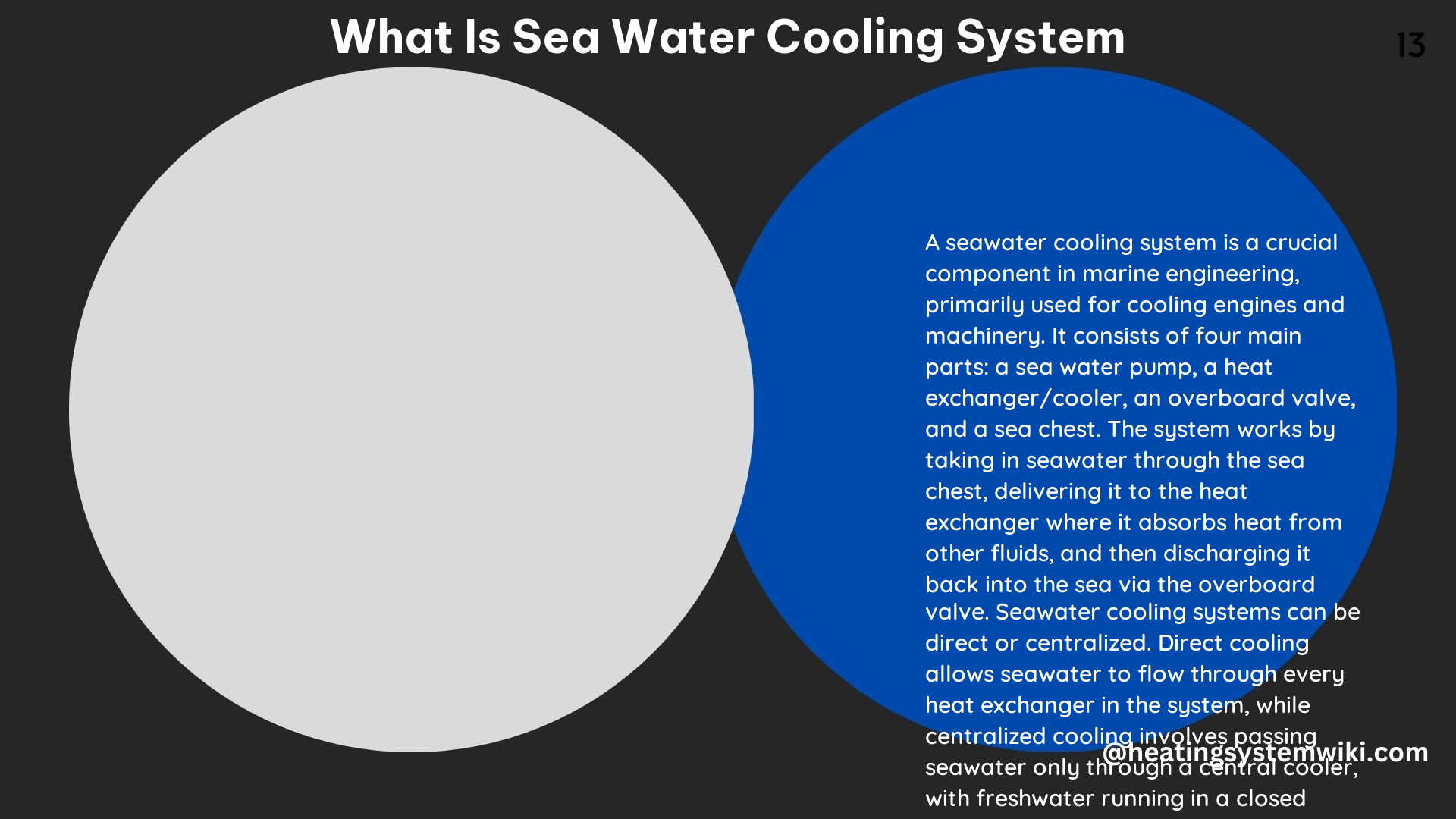A sea water cooling system is a crucial component in various applications, such as ships and power plants, to remove excess heat from the system. It works by using seawater as a coolant, which is drawn from the sea through a seawater intake and then pumped through a heat exchanger to transfer the excess heat from the system to the seawater, which then exits the system and is returned to the sea.
Understanding the Components of a Sea Water Cooling System
In a ship’s engine room, the sea water cooling system is composed of four main parts:
- Sea Water Pump: This pump takes suction from the sea through the sea chests and delivers the seawater into the heat exchangers or coolers.
- Heat Exchanger or Cooler: These are designed to absorb the heat from the other fluids flowing through them, such as the cooling jacket water or lubricating oil.
- Overboard Valves: These valves allow the seawater to exit the system and go back to the sea after absorbing the excess heat.
- Sea Chests: These are the openings in the ship’s hull that allow the seawater to be drawn into the cooling system.
Types of Heat Exchangers Used in Sea Water Cooling Systems

There are two main types of heat exchangers commonly used in sea water cooling systems on board ships:
- Tube Type Coolers:
- In these coolers, the seawater passes through a set of tubes, usually made of brass.
- The hotter fluid, such as jacket water or lubricating oil, passes through the shell where it comes into contact with the tubes and transfers heat to the metal by conduction.
-
Tube type coolers are known for their durability and ease of maintenance, but they can be more susceptible to fouling and scaling due to the direct contact between the seawater and the heat transfer surfaces.
-
Plate Type Coolers:
- In these coolers, metal plates, usually made of stainless steel or titanium, are used instead of tubes.
- Both the seawater and the hotter fluid flow through either side of the plates alternatively, allowing for efficient heat transfer.
- Plate type coolers are generally more compact and have a higher heat transfer rate compared to tube type coolers, but they can be more sensitive to fouling and require more frequent cleaning.
Styles of Sea Water Cooling Systems on Modern Ships
There are two different styles of seawater cooling systems used on board modern ships:
- Direct Cooled Systems:
- In these systems, the seawater itself flows through every heat exchanger in the system.
- This design is simpler and more straightforward, but it can lead to increased corrosion and maintenance requirements due to the direct contact between the seawater and the various components.
-
The seawater flow rate in a direct cooled system is typically around 1.5 to 2.5 times the flow rate of the fluid being cooled.
-
Centralized Cooling Systems:
- In these systems, freshwater running in a closed circuit is the medium that goes through all the other heat exchangers.
- The freshwater absorbs the heat from the various systems and then passes through a central cooler, where it transfers all the heat to the seawater, which then exits the system and goes back out to the sea.
- Centralized cooling systems offer several advantages, such as less corrosion, lower maintenance costs, and the ability to use more efficient heat exchanger designs.
- The seawater flow rate in a centralized cooling system is typically around 0.5 to 1 times the flow rate of the freshwater circuit.
Factors Affecting the Design and Performance of Sea Water Cooling Systems
The design and performance of a sea water cooling system are influenced by several factors, including:
- Seawater Temperature: The temperature of the seawater can vary significantly depending on the location and depth of the intake, as well as the season. This can affect the cooling capacity and efficiency of the system.
- Seawater Salinity: The salinity of the seawater can impact the corrosion rate of the system’s components, requiring the use of more corrosion-resistant materials.
- Seawater Fouling: Marine growth, such as algae, barnacles, and mussels, can accumulate on the heat exchanger surfaces, reducing the heat transfer efficiency and increasing the pressure drop in the system.
- Seawater Intake Design: The design of the seawater intake, including the size and location of the sea chests, can affect the amount of debris and sediment that enters the system, which can lead to fouling and clogging.
- System Load: The cooling load of the various systems being cooled, such as the engine, generator, and other auxiliary equipment, can vary significantly and affect the sizing and performance of the sea water cooling system.
Maintenance and Troubleshooting of Sea Water Cooling Systems
Proper maintenance and regular monitoring of a sea water cooling system are crucial to ensure its reliable and efficient operation. Some key maintenance tasks include:
- Cleaning and inspecting the heat exchangers for fouling and scaling
- Checking the seawater pump for proper operation and wear
- Monitoring the seawater intake for debris and sediment buildup
- Inspecting the overboard valves and sea chests for any obstructions or damage
- Performing regular water quality tests to detect any changes in seawater composition
Common troubleshooting issues in sea water cooling systems may include:
- Reduced cooling capacity due to fouling or scaling
- Increased pressure drop due to clogging or blockages
- Corrosion of system components
- Seawater pump failures
- Leaks in the heat exchangers or piping
Addressing these issues promptly and implementing preventive maintenance measures can help ensure the long-term reliability and performance of the sea water cooling system.
Reference:
